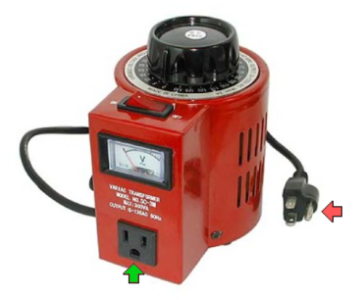You are using an out of date browser. It may not display this or other websites correctly.
You should upgrade or use an alternative browser.
You should upgrade or use an alternative browser.
can a two prong variac be converted to a three prong variac?
- Thread starter jeremy
- Start date
Artie
Peaveyologist
Sure. The 3rd prong of the plug is connected to the neutral prong back at the breaker box. Just connect the 3rd prong of your new input cord to the 3rd prong of the new outlet. There would be no connection to your variac itself. Just make sure to reorient neutral-to-neutral and line-to-line on the new cable and outlet.
But ask an electrician.
But ask an electrician.
Last edited:
ErikH
Well-known member
Oh he's talking about changing the cord on the variac
not the receptacle on the wall
connect the hot and neutral (black and white respectively) in the same places as the two wire existing cord
connect the green to the metal chassis
Yeah. That’s what I was thinking. Same as changing an old 2 prong amp to 3. Center pin goes to chassis. The outlet ground pin goes to ground per code.
Artie
Peaveyologist
Oh he's talking about changing the cord on the variac, not the receptacle on the wall.
I get that. But the variac itself has a receptacle. I meant 3rd prong, wire-to-wire on the variac cord-to-receptacle. It would mean also replacing the receptacle on the variac.
At least, I thought that's what he meant.
ErikH
Well-known member
Ohhhh, right. Otherwise, how else would it work. Duh! (silly me).
Well, that being said, I would think wiring it up to match what goes to the wall would be the ticket. That is, if you're converting the cord to the wall and the appliance receptacle at the same time. Receptacle ground pin to the cord ground pin so when it's plugged in to the wall, all 3 pins are connected as they should.
I would double-check with a few amp techs to verify that.
Well, that being said, I would think wiring it up to match what goes to the wall would be the ticket. That is, if you're converting the cord to the wall and the appliance receptacle at the same time. Receptacle ground pin to the cord ground pin so when it's plugged in to the wall, all 3 pins are connected as they should.
I would double-check with a few amp techs to verify that.
ehdwuld
A Ficus
Yes . . . connect wire from red arrow, (new cord), to green arrow, (new internal receptacle).
Would you wire directly
or to a common lug on the housing
I assume you would have to create a common lug
I would want to ground the metal case as well
Artie
Peaveyologist
Would you wire directly
or to a common lug on the housing
I assume you would have to create a common lug
I would want to ground the metal case as well
The jury's still out on that. When whatever what electrical committee made these rules, 51% voted "yay", lets do 3-prong. 49% voted "nay" . . . It's stupid since the 3rd prong and neutral are shorted together back at the panel. (Their comment. Not mine.) Most diagrams keep it separate, on a variac. Connected, on most other equipment. That way, the connection is determined by what you plug into it.
Similar threads
- Replies
- 17
- Views
- 415
- Replies
- 2
- Views
- 173
- Replies
- 22
- Views
- 428
- Replies
- 6
- Views
- 149

